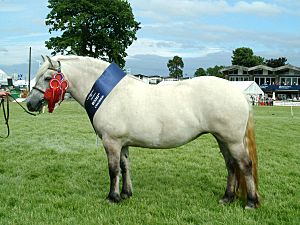Highland pony facts for kids

Highland Pony Champion at the Royal Highland Show 2005
|
|
| Country of origin | Scotland |
|---|---|
| Breed standards | |
|
|
The Highland Pony is a special horse breed from Scotland. It's one of the biggest mountain and moorland pony breeds found in the British Isles. These ponies have a long history, going back to the 1880s!
Long ago, Highland Ponies worked hard on farms in Scotland. They pulled timber and helped with other tasks. Today, they are popular for many activities. People use them for pulling carts, trekking (long rides), and general riding. These ponies are very strong and tough. They often don't even need special shoes for their hooves. Plus, they are not expensive to look after!
Contents
What Makes a Highland Pony Special?
Highland Pony Features and Traits
The Highland Pony is one of three native horse breeds from the Highlands and Islands of Scotland. The other two are the Shetland Pony and the Eriskay Pony. Over hundreds of years, this breed has learned to live in Scotland's changing weather. Scotland can be very cold and stormy!
Their winter coat is amazing. It has a layer of strong, badger-like hair. Underneath, there is a soft, thick layer of fur. This special coat helps them stay warm in all kinds of weather. In spring, they lose this thick coat. Then, they have a smooth summer coat. This toughness comes with a kind and calm nature.
Size and Body Shape
Highland Ponies usually stand between 13 and 14.2 hands tall. Their head is held high and looks alert. They have kind eyes, a wide muzzle, and a deep jaw. A good Highland Pony has a neck of reasonable length. Its shoulders slope well, and its forearms are placed nicely.
These ponies have a balanced and strong body. They have a deep chest and well-rounded ribs. Their back legs are powerful, with strong thighs. Their lower back legs (gaskin) are also strong. Their hocks (joints on the back legs) are clean and flat. Important traits include strong, flat bones. They also have wide knees and short cannon bones. Their pasterns (part of the leg above the hoof) are sloped. Their hooves are well-shaped, wide, and dark.
Highland Ponies have soft, silky hair behind their fetlocks. When these ponies are shown in competitions, their manes and tails are kept natural. They are long, flowing, and not trimmed.
Highland Pony Colors and Markings
Highland Ponies come in many shades of dun. The Highland Pony Society recognizes different dun colors. These include "mouse" (also called grullo in other breeds). There's also "yellow" (which is bay dun). "Grey" is a dun color that gets lighter as the pony gets older. "Cream" is a dun with an extra lightening gene.
Sometimes, people use other names for colors. These include "fox dun" (a red dun), "oatmeal dun", and "biscuit dun" (a cream dun). Highland Ponies can also be grey, seal brown, or black. Sometimes, they are bay or a shade of liver chestnut. These might have a flaxen (light-colored) mane and tail.
Dun-colored ponies often have special markings. These are called primitive markings. They include a dark stripe down their back (dorsal stripe). Some also have zebra-like stripes on their legs. A stripe across the shoulders is also common. Foal (baby pony) coat colors often change as they grow. Some ponies also change color slightly between their winter and summer coats. Colors like pinto (large patches of white and another color) are not allowed.
The Highland Pony Society does not like white markings. A small white star on the forehead is usually the only white allowed. Stallions (male horses) with other white markings cannot be officially approved. Ponies with white markings (other than a small star), white legs, or white hooves are not allowed in shows.
Highland Pony History
It can be tricky to trace the exact history of this breed. In the past, there were two main types. One was a small, light pony from the Western Isles. The other was a larger, heavier type from the mainland. The larger ones were sometimes called garrons. Today, these two types have mixed together. So, there is less difference between them within the breed. However, the smaller type still exists in the rare Eriskay Pony.
In the 1500s, horses from France and Spain came to the Scottish Highlands. These included the Percheron breed. In the 1800s, other breeds were added. These included a Hackney type, the Fell Pony, and the Dales Pony.
Highland Ponies were first bred to work on small Scottish farms. They helped pull timber and game. They also helped with ploughing fields. They are still used for some of this work today. But mostly, people enjoy them as all-around ponies. They are good for jumping and trekking. This is because they are calm, have lots of energy, and can carry heavy loads.
Today, there are about 5,500 Highland Ponies left in the world. Most of them live in Europe. Some are still bred for their strength and stamina. But many are now bred to be better for riding and driving. This breed is also often crossed with Thoroughbreds. This mix creates good horses for eventing (a horse sport). Even with growing popularity, the breed is still "at risk." It is listed in category 4 by the Rare Breeds Survival Trust.

